Canon Rangefinder 100mm Medium Telephoto Lenses
A Description of Canon Rangefinder 100mm Lenses produced 1948-1975
Canon 100mm Lenses
The 100mm medium telephoto lens was something of a speciality of Canon over the years. Other manufacturers seemed to prefer 90mm for a medium telephoto and neither Leica 9 nor Nikon 10 ever made a 100mm rangefinder lens. But for Canon, the Canon Serenar 100mm - or rather 10cm as the labeling was then - was the third lens Canon manufactured. It followed the 50mm f3.5 of December 1945 and the 135mm f4.0 of January-February 1948. 2 Also, beginning with the new three position viewfinder introduced on the Canon IIB at the beginning of 1949, Canon rangefinders included a viewfinder image for the 100mm focal length without an accessory finder (although Canon usually did offer a 100mm accessory finder with its lenses.)
Canon Serenar 100mm f4.0
Canon introduced this lens, initially labeled Serenar 10cm f4.0, in February 1948. 2
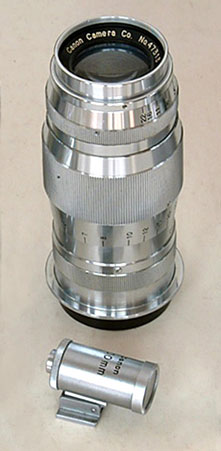
The lens was of a heavy chrome on brass construction. By 1949 with the introduction of the Canon IIB, the lens was labeled "Serenar 100mm" as shown in the photograph above. It was sold in a fitted leather case with an accessory viewfinder in the lid.
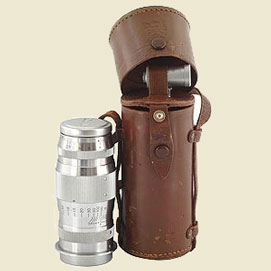
The Canon 100mm f4.0 with its leather case and accessory viewfinder
This lens was of a simple design: 3 elements in 3 groups, each element well spaced. It accepted a 34mm adaptor ring for Series VI attachments.
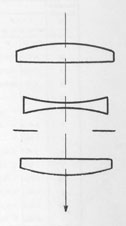
Serenar 10cm f4 design
Production of this lens continued until the summer of 1952 when the new 100mm f3.5 was introduced. During its 4 1/2 years of sales, the 100mm f4.0 lens sold 4,324 units, significanly less than the 16,724 units of the Serenar 135mm F4.0 sold during approximately the same period.
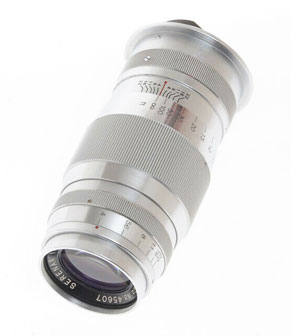
Canon 100mm f3.5
In October 1952, Canon introduced the 100mm f3.5 lens, first as a Serenar until the conversion to "Canon Lens" at the end of the year. The new lens, although somewhat faster, was only half the weight of the f4.0 lens (205 grams versus 459 grams) being made of new lighter alloys. It also had a stylish satin chrome with black rings finish - quite attractive for that time.
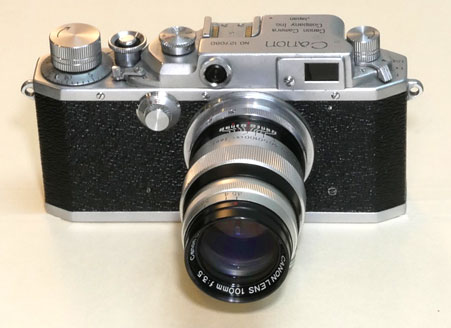
the black on chrome Canon 100mm f3.5 of 1953 mounted on a contemporaneous Canon IID camera
This lens was of a more complex design than the f4.0: 5 elements in 4 groups. It accepted a 34mm adaptor ring for Series VI attachments.
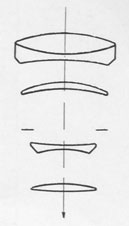
Canon 100mm f3.5 design design
In March, 1960, Canon changed the lens barrel for the Canon 100mm f3.5 to an all-black body, similar to the lens barrel finish of its other lenses at that time, such as the Canon 135mm. f3.5 lens
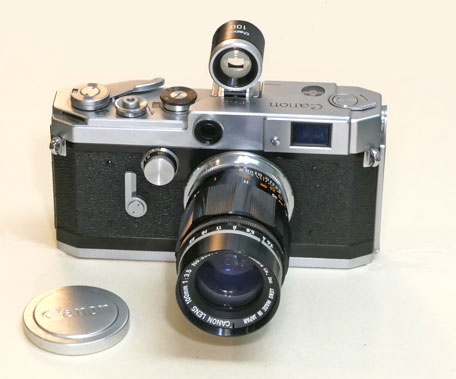
the black Canon 100mm f3.5 lens on a Canon VL2 with Canon 100mm accessory finder
this accessory finder had an adjustable base with a pin which linked to another pin in the accessory shoe of this Canon VL2 and others. The pin system raised and lowered the finder as focusing changed, thus adjusting for parallax.
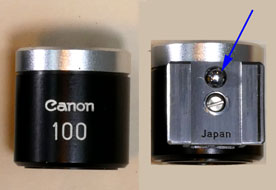
Canon continued the production of this black 100mm f3.5 lens until the end of their rangefinder lens production in 1975. During its production of the improved 100mm f3.5 lens om 1952 until end of production in 1975, Canon produced 44,696 units of this compact medium telephoto. The continued production well after the end of Canon M39 rangefinder camera production was due to the high reputation of the lens among active photographers.
Canon 100mm f2.0
A further example of Canon's long support of the 100mm lens as a desireable medium telephoto was the Canon 100mm f2.0 released in January 1959. Of course, given its much wider aperture, the 100mm f2.0 was dramatically larger and heavier than the 100mm f3.5 lens.
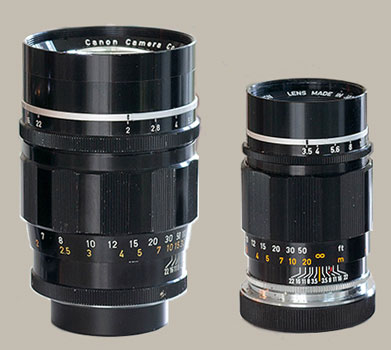
the Canon 100mm f2.0 compared with the 100mm f3.5
The Canon 100mm f2.0 was a lens of 6 elements in 4 groups
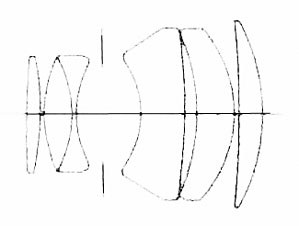
The 100mm f2.0 proved to be as prized by photographers of the 1960s and 1970s as was the 100mm f3.5. Both continued in production until the end of Canon's manufacture of rangefinder lenses, and even today fetch a high price in secondary markets. Given that the Canon 100mm f2.0 is necessarily a lens for specialty purposes, such as portraits, fashion photography, and available light photography, the total production of the lens - 6655 units was certainly respectible.
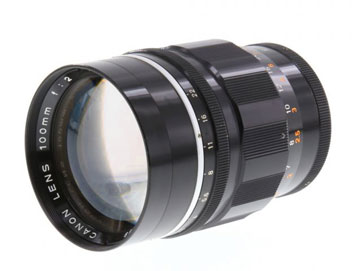
the Canon 100mm f2.0 of 1960
Summary of the Canon 100mm medium telephoto
Canon's long support of the 100mm medium telephoto, and its series of some of the best-performing rangefinder camera lenses of each decade of its production is among the highlights of Canon's impressive history of leading lens productions.
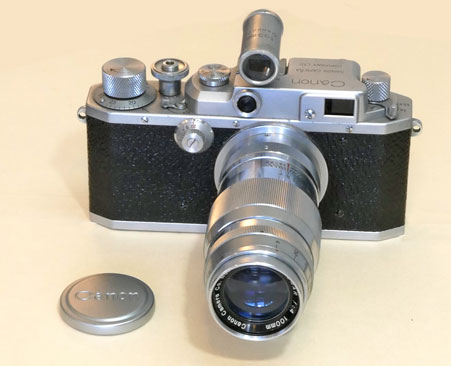
a 100mm f4.0 lens of 1950 on a contemporaneous Canon IIB camera
You can click on the links in the table below to consult other pages of the canonrangfinder.org site.
| Navigation: Click Below to Jump to Desired Subject Page | ||
|---|---|---|
| Canon Rangefinder Cameras - 1 | Canon Rangefinder Cameras - 2 | Canon Rangefinder Lenses |
| Canon S | Canon IVSB2 | Canon 19mm |
| Canon J | Canon IIS2, IID2, IIF2 | Canon 25mm |
| Canon NS | Canon VT, Canon L2 | Canon 28mm |
| Canon JS | Canon L1, L3 | Canon 35mm |
| Canon J-II | Canon VT Deluxe | Nikkor 50mm |
| Canon S-II | Canon VL, VL2 | Canon 50mm |
| Canon IIB | Canon VI-L, VI-T | Canon 85mm |
| Canon III, IIC, IV | Canon P | Canon 100mm |
| Canon IIIA, IVF, IVS | Canon 7 | Canon 135mm |
| Canon IIA, IID, IID1 | Canon 7s | Canon 200mm-1000mm |
| Canon IVSB | Minolta Rangefinders | Minolta Lenses |
| Canon IIF, IIS | Other Rangefinders | other M39 lenses |
| Go to canonrangefinder.com home page | ||
Any additions or corrections to these pages would be welcome simply by contacting this site as shown at the foot of this page .
Footnotes:
1 Dechert, Peter. Canon Rangefinder Cameras 1933-1968. Hove Collectors Books. West Sussex, United Kingdom. 1985. ISBN 0-906447-30-5.
Peter Dechert's book is the most important expert source of information regarding Canon Rangefinder Cameras.
2 Kitchingman, Peter. Canon M39 Rangefinder Lenses 1939-1971. A Collector's Guide. Published by Peter Kitchingman. Perth, Australia. 2008. ISBN 978-0-646-48144-9.
Peter Kitchingman's book is the definitive study of the more than three decades of M39 format camera lenses developed for Canon Rangefinder Cameras.
3 Nostalgic Canon Camera Book. 懐かしいキヤノン EI Publishing Co. Ltd. Tokyo, Japan. June 2003.
Peter Kitchingman's book is the definitive study of the more than three decades of M39 format camera lenses developed for Canon Rangefinder Cameras.
4 "Canon Camera Museum" history website. https://global.canon/en/c-museum/history/ published by Canon, Inc. accessed in 2019.
5 Rajner, Hans P. (author), John Wade (editor). Leica Copies. Classic Collections Publications. London, UK. ISBN 13: 9781874485056
Hans P. Rajner's book is an excellently detailed and carefully researched study of camera from around the world which used the Leica M39 lens mount and the same lens to film plane distance.
7 Dechert, Peter. Canon Single Lens Reflex Cameras 1959-1991. Historical Camera Publications. Yakima, Washington. 1992. ISBN 1-879561-04-2.
8 Tomlinson, Shawn M. The Film Photography Book. Lulu Pulbications. 2016. ISBN: 9781365263972
9 Sartorius., Ghester. Identifying Leica Lenses. Classic Camera 19. Tokyo, Japan. 2001. ISBN 4-257-12029-0
10 website http://www.nicovandijk.net/rflensmatrix.htm consulted 2019.
11 O'Reagan, Douglas M. Allied Exploitation of German Science after World War II. Johns Hopkins University Press. Baltimore, Maryland. 2019. ISBN 9781421428888
If you have any comments or questions about this Canon Rangefinder site, please e-mail me (Larry Huffman) at e-mail address: [email protected]